Back to blog
9 MIN READ
How to Increase Mobile App Engagement (10 Key Strategies)
PUBLISHED
7 November, 2024

Product Analytics Expert
Potential customers know their worth more than ever. From simple websites to mobile apps, they are quick to offboard from experiences that don’t meet their expectations or cause them even just a little bit of trouble. This is why it’s super important to increase your mobile app engagement.
Fortunately, at UXCam, we know all about using user behavior data to help improve your mobile app experience so your users keep coming back.
Read on to learn our top strategies to increase your mobile app engagement!
Summary - Mobile app engagement strategy
| Strategy | Description |
|---|---|
| Measure Engagement | Use analytics tools like UXCam to understand user behavior and identify issues. |
| Simplify Sign-Up | Reduce registration steps to ≤3 and allow sign-up via social media, email, or phone. |
| Personalize Onboarding | Tailor the welcome experience, simplify navigation, let users choose interests, and offer rewards. |
| Preview App’s UI | Show the app’s interface before sign-up to highlight its user-friendly design. |
| Enable Gamification | Add rewards, badges, and challenges to make the app fun and encourage return visits. |
| Smart Push Notifications | Send personalized, relevant notifications without overwhelming users. |
| Two-Way Communication | Provide real-time in-app support and quickly respond to user queries to build trust. |
| Add Social Features | Create an in-app community with chat, voice, or video to foster user connections. |
| Re-Engage with Email | Send personalized emails to inactive users for feedback and encourage them to return. |
| Continuous Testing | Regularly experiment and refine engagement strategies to keep users interested. |
What is mobile app engagement?
Mobile app engagement is the measure of interaction between a user and a mobile app. Your mobile app engagement gives you an idea of how users respond to your app as a whole or via specific features.
Great engagement is what you need to make your mobile app successful. According to a study from Rosetta Consulting, this is because engaged users spend more, help you generate useful data that you can use to improve, and provide you with touchpoints that you can capitalize on.
Effectively measuring your mobile app engagement involves various metrics. So, let’s take a look at some useful ones that you should be paying attention to.
Why is mobile app engagement important?
Improves the credibility of your app
Your mobile app engagement essentially signifies the ‘health’ of your overall business. Engaged users create a strong customer community that can vouch for the credibility of your business. So, prioritizing high app engagement will encourage users to keep returning to your app and recommend your app to others. After all, word-of-mouth is one of the most reliable ways to build trust with your users.
Improves customer lifetime value
If you neglect your app engagement strategy, you run the great risk of lowering your customer lifetime value (LTV) because you won’t be retaining as many users as you’re capable of. Your customer lifetime value will improve as you will be aware of where user engagement is low (or high) and make the necessary improvements to keep your users engaged and drive more revenue.
Get to know your users better
As you monitor your app engagement metrics, you’ll constantly be learning about your users and what it is they approve of or dislike about your app. Additionally, with more active users comes even more useful information. Ultimately, the better you get to know your users, the easier you can improve your app to consistently meet their needs and exceed their expectations.
Here is a great example:
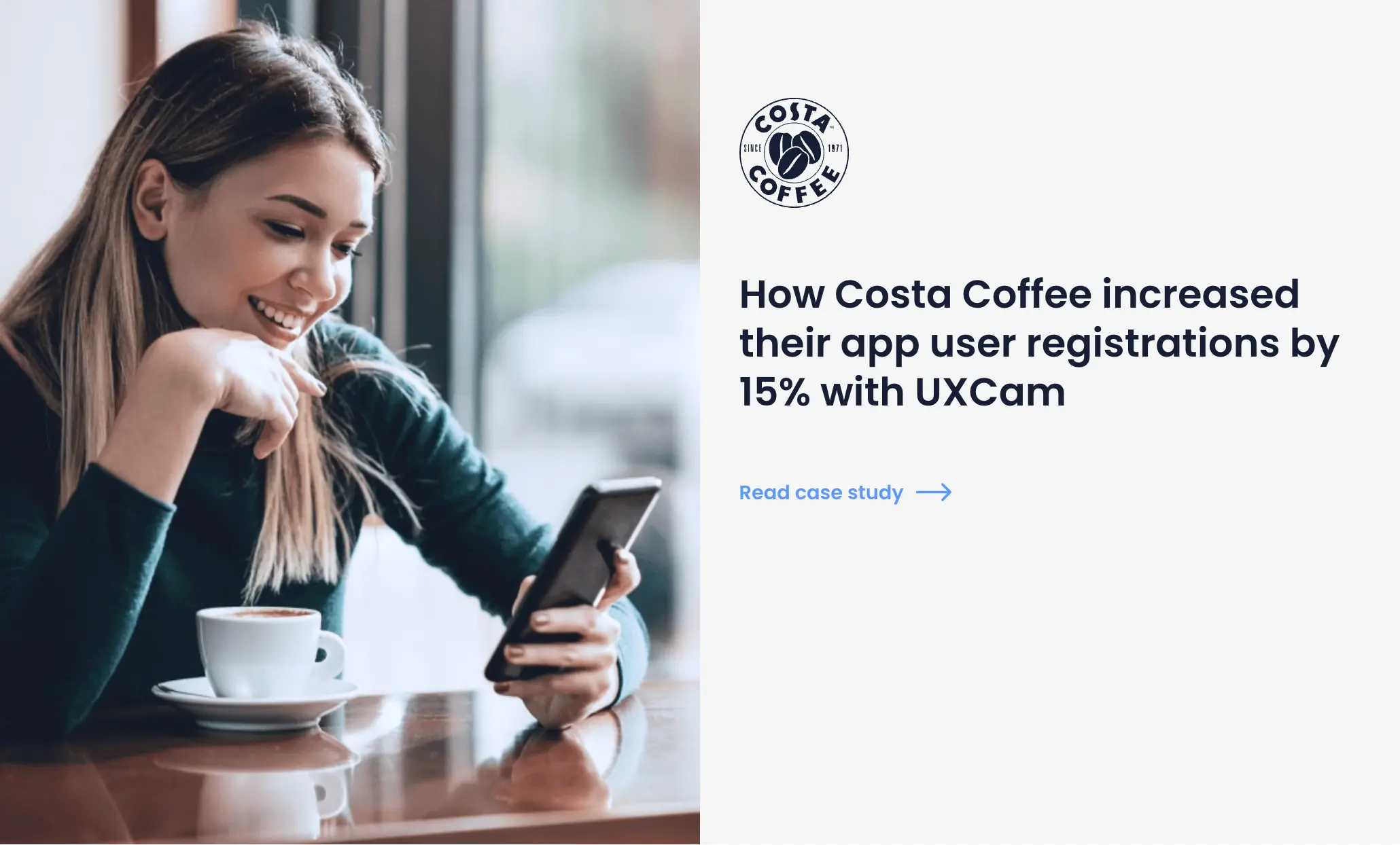
How Costa Coffee increased their app user registrations by 15% with UXCam
The global coffee brand Costa Coffee needed a solution to help lower their 30% drop-off rate so that more users would sign up for their loyalty program. With the help of UXCam’s qualitative analytics for their mobile app, they were able to identify the reason why people were initially dropping off before registering for a loyalty program.
By cracking down on useful app engagement analytics, Costa Coffee saw from their customers’ perspectives what was making registration so difficult. Ultimately, they were able to make appropriate design changes to revamp the process and achieved an increase in registrations by 15%.
Top 10 strategies to improve mobile app engagement
Measure engagement
Simplify the sign-up process
Personalize the user onboarding process
Give users a preview of the app’s UI
Enable app gamification
Use push notifications strategically
Build relationships with 2-way communication
Add a social component
Use email to bring users back to the app
Keep testing
How to increase mobile app engagement
Let's dive into each strategy and how to increase user engagement on mobile apps.
Measure engagement
The first step to improving your mobile app engagement is to identify what your current engagement looks like. This way, you can gauge the value your customers are currently getting and pinpoint exactly where their issues may lie.
So how can you measure your engagement? With a reliable mobile app analytics tool! UXCam helps you step into the shoes of your customers so that you can better understand their journey with your app. You can simply set up mobile app tracking and immediately receive insights on your app user behavior and track it over time.
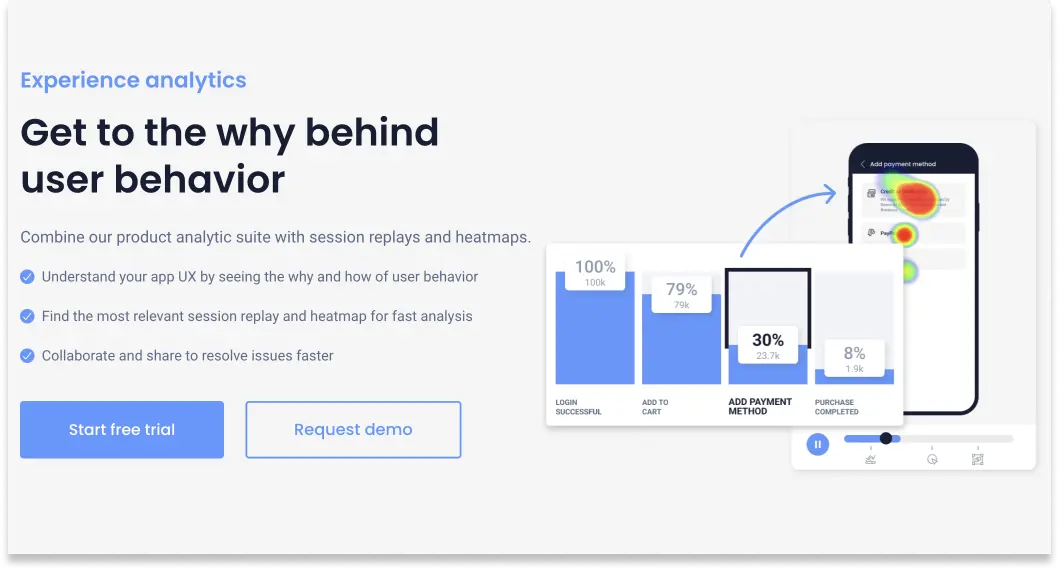
Simplify the sign-up process
If we refer back to our Costa Coffee example, a glitch in the registration process can lead to a massive drop in user engagement. Nobody wants to go through a lengthy or complicated sign-up process. Thus, you need to make sure that users can sign up for your app in three or fewer steps.
To ensure a seamless experience, it’s crucial to perform thorough testing using all possible test cases for the registration page, identifying and resolving any issues that could hinder the sign-up process.
Another effective option is making it possible for users to sign up using their social media accounts, emails, or phone numbers.


Personalize the user onboarding process
When implementing a long-term vision for your customers, the first impression is everything. You can start off by personalizing the welcome page for all your users using the registration info they offered.
Then, you can proceed to sweeten the onboarding app process with these extra inclusions:
Simplify the app interface so that it’s easy for users to navigate
Provide options for users to select their specific interests surrounding your business
Offer incentives for recurring sign-ins (e.g., discounts on services)
By doing this in the early onboarding process, you show your users that they matter to you, and it will encourage them to keep engaging with your app.
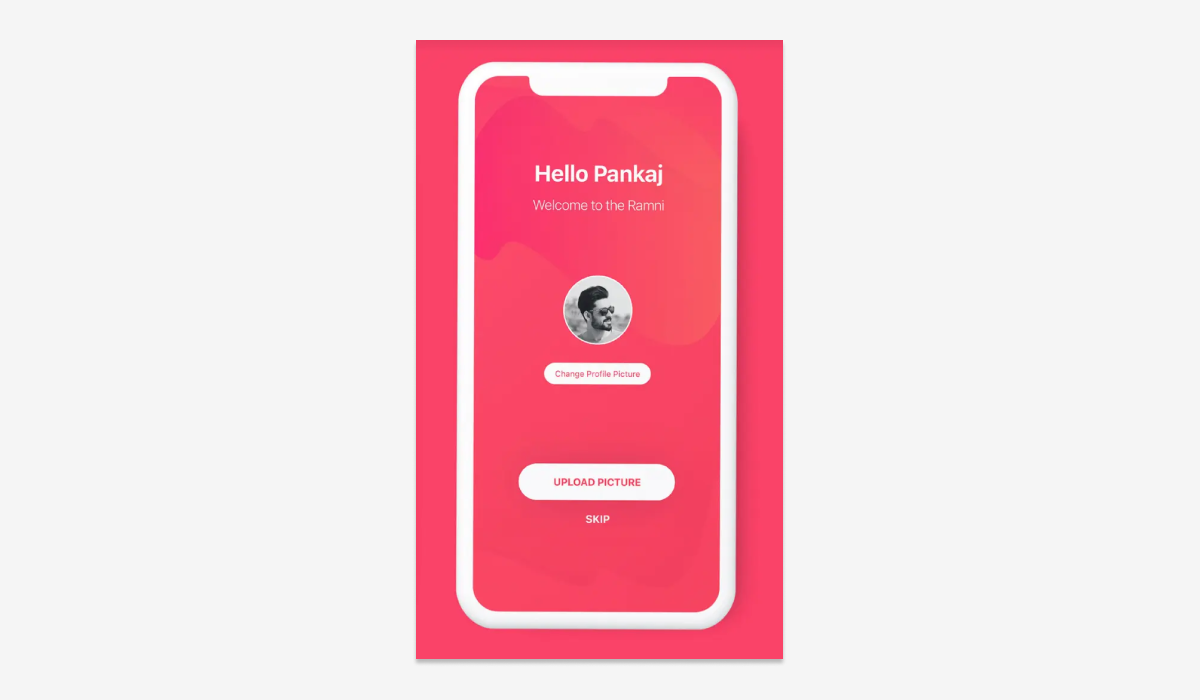

Give users a preview of the app’s UI
Ensuring you increase your user retention rates can be as simple as offering a preview of your app’s user interface. Your users will have an effective visual of what they’re getting into. So, make sure to showcase just how user-friendly your app’s design is before a customer even signs up.
Slack is a platform that does this well for their iOS mobile app. On their welcome screen, they display what their user interface looks like on iOS and desktop. This helps their users understand how easily they can communicate from one platform on multiple devices.
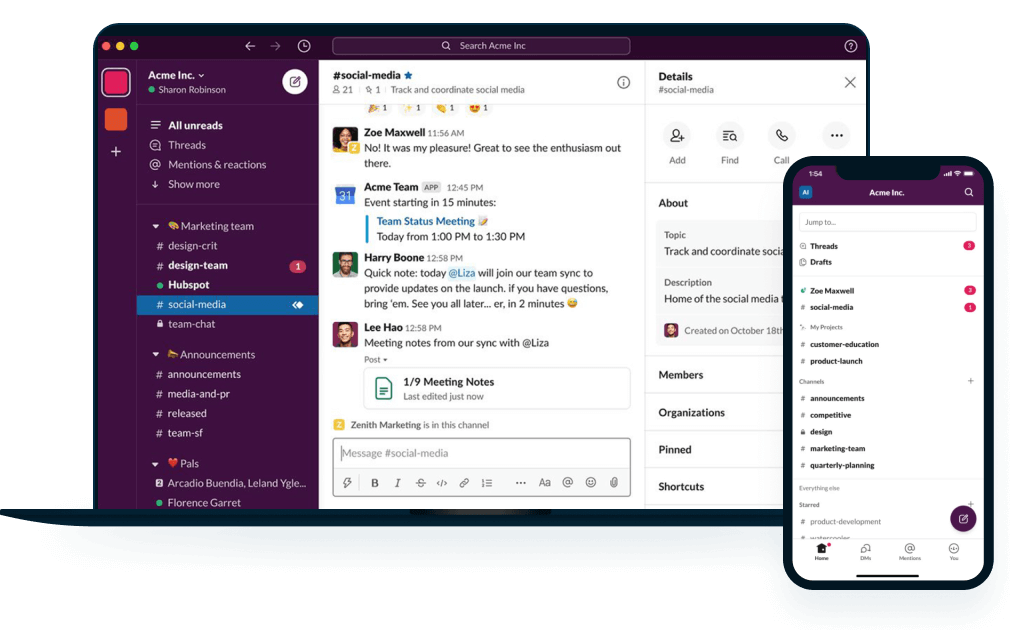

Enable app gamification
An effective way to boost your user engagement is to add some fun and excitement to your app. Thus, implementing some gaming elements is a surefire way to ensure your customers keep using your app.
Some gamification ideas you can consider are:
User rewards for performing certain actions in the app
Badges for reaching milestones or using the app for a specific period of time
Location-based challenges (e.g., gaining discounts for performing an in-store task)
Use push notifications strategically
Push notifications can be a hit or a miss when it comes to mobile apps. They are useful for providing helpful information to your users, but not if they’re coming in constantly. So, it’s best to make sure your notifications aren’t too frequent so that your users don’t find your app annoying.
Personalizing your push notifications for each user is a great way to lower the abandonment rate of your app and keep you at the top of users’ minds. Personalization can include using a person’s name in a message and promoting products or deals that match user interests and app behavior.
Build relationships with 2-way communication
Your in-app messaging capabilities are essential so that you can give real-time assistance to users when they need help. For your in-app messaging to be effective, you need to make sure that users are getting their questions answered in less than a few hours. This way, you can build trustworthy relationships and lessen frustrating situations that can turn users off your app.
Add a social component
Creating an in-app community can help you increase user engagement because users are 2.7 times more likely to stay on your app when they feel a sense of belonging.
Dedicate a section in your mobile app where your users can interact with each other and the larger community. Chat is a great place to start, but you can also consider including voice and video features to elevate the experience further.
The period-tracking app, Flo, does an amazing job of bringing its users together with in-app messaging and discussions that anyone can join in on.
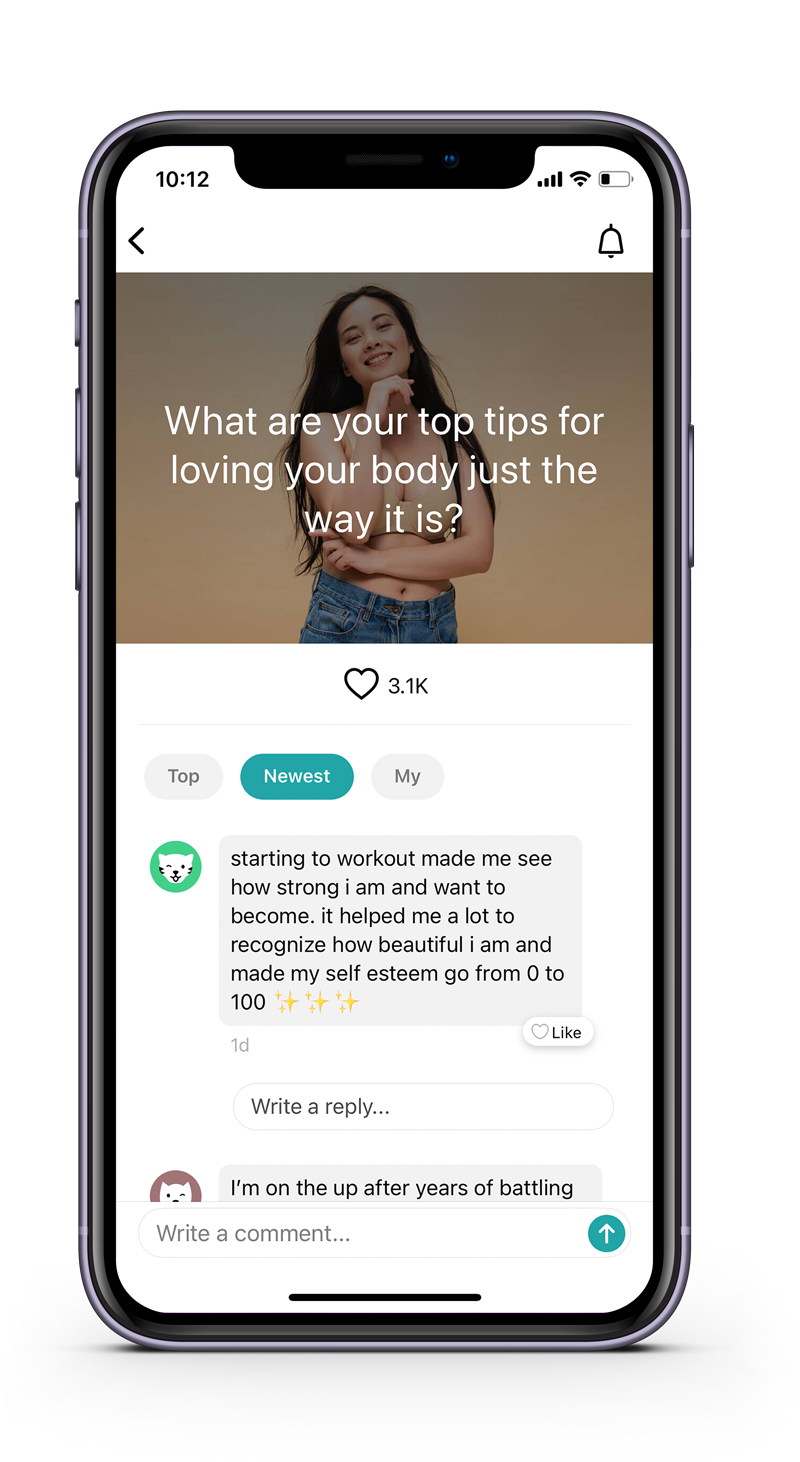

Use email to bring users back to the app
Most of the strategies we’ve looked at so far need the user to be on your app. But what if they’re not? Perhaps a user has disabled their push notifications for your app, and you need another way to encourage them to keep engaging. This is where emails come in.
You can send personalized emails that directly engage with the user and allows them a space to provide feedback on why they stopped using your app. This can show users that you’re serious about their experience on app, and could encourage some disengaged users to come back!
Keep testing
Like most things in SaaS, increasing mobile app engagement is not a “one-and-done” activity. You need to continuously review and test your in-app engagement tactics so that you can improve them. Stay open to experimenting with new and better ways to keep your users engaged.
Different metrics to measure mobile app user engagement
Active users
Your daily and monthly active user count is a strong baseline indicator of how engaging your app is. This metric goes beyond reviewing the number of people who have downloaded and installed your app on their device. You need to measure how many people are regularly interacting with your app to know if it’s effective.
Retention rate
The retention rate metric measures the number of customers who have downloaded your app and continue to actually use it over a certain period of time. It’s probably the most crucial metric for a mobile app team to measure because you can’t improve your engagement if people aren’t using your app anymore. Understanding your retention rate will help you secure more long-term engagement for your app.
Churn rate
The churn rate metric measures the number of users that leave your app over a certain period of time. Of course, a high churn rate is bad news, and this is why you need to stay on top of it. High churn indicates that there’s something in your app that’s causing users to bounce off, so you should identify the issue quickly and fix it before it becomes an issue for multiple users.
Average session length
The average session length metric tells you the average time a user spends on your app during a session. Overall, this length is determined by measuring the time between opening and exiting the app. However, to ensure the measurement of engaged users, it will narrow down to the time between the first app action and the last.
UXCam has a great mobile session recording feature so you can watch and replay how an individual uses your app. This way, you’ll get genuine insights into how long your users are spending navigating your app and identify areas that caused users to churn.
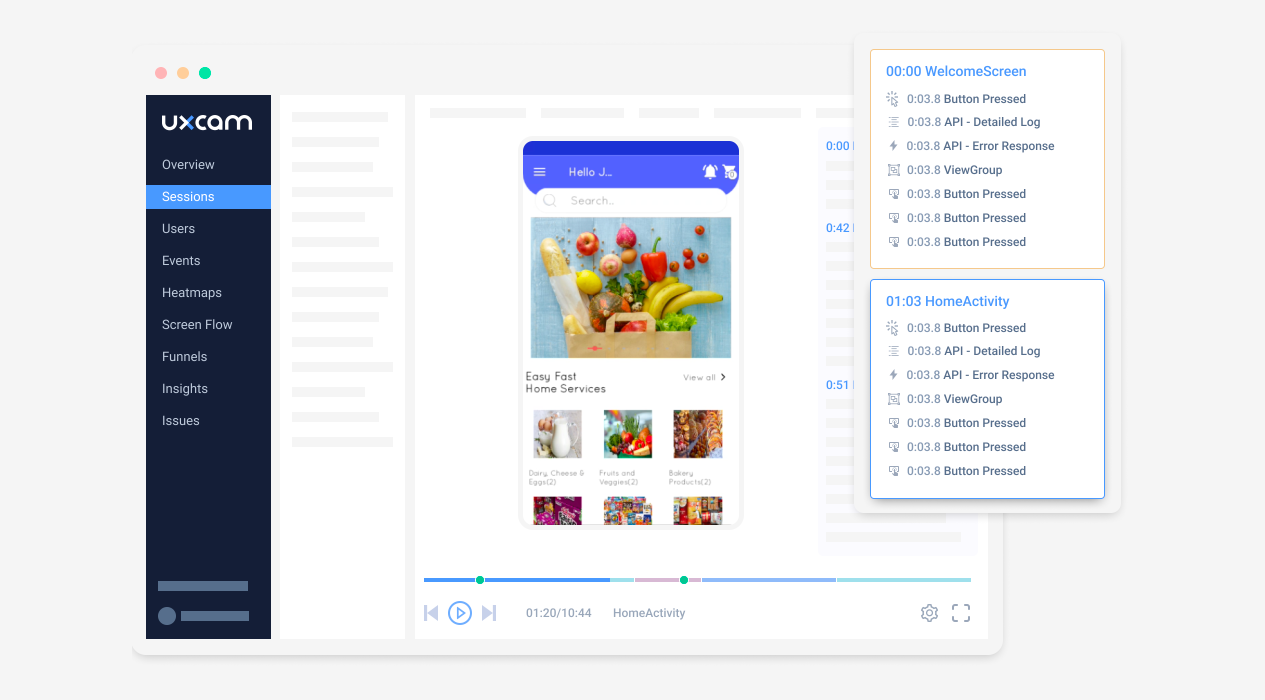

Increase your mobile app engagement with UXCam
Customer needs are constantly changing, so your app engagement strategies must adapt to the current customer expectations. Analyzing user behavior data and listening to your users will give you the insights you need to optimize your mobile app experience.
You’re in luck because UXCam can deliver the 360-degree insights that product teams need to elevate their mobile engagement. Want to know more? Feel free to request a demo to find out exactly how we can help you improve your mobile app engagement!
FAQs
Mobile app engagement strategy FAQs
How to increase user engagement rate?
Engagement rate increases when users find value, relevance, and ease in using the app. Strategies include personalizing content, simplifying navigation, sending timely push notifications, offering in-app rewards, and continuously optimizing the user experience based on behavior data.
What metrics measure mobile app engagement?
Key metrics include: Daily active users (DAU), Session length and frequency, Retention rate, Churn rate, In-app actions and feature usage, Push notification open rate
What tools help improve app engagement?
Tools like UXCam, Firebase, OneSignal, Braze, and Mixpanel help improve engagement by tracking in-app behavior, sending targeted messages, personalizing user experiences, and identifying friction points.
You might also be interested in these; What is product engagement? (and how to improve it)
Mobile app engagement benchmarks - How to measure success
10 mobile app engagement metrics to track and measure
How to to Improve Mobile App Performance
6 Best user engagement tools for product teams
Using UX gamification to drive app engagement (with examples)
AUTHOR

Tope Longe
Product Analytics Expert
Ardent technophile exploring the world of mobile app product management at UXCam.
What’s UXCam?
Related articles
App Analytics
Mobile App Tracking: Practical Guide & Best Tools [2026]
The best tracking tools for mobile...

Jonas Kurzweg
Product Analytics Expert
App Analytics
Top Analytics SDKs 2026
Pick the right analytics SDKs to improve your app's...

Jonas Kurzweg
Product Analytics Expert
Product best practices
8 Best UX Analytics Tools and Software We’ve Tested 2025
A good UX design is key when it comes to user satisfaction. Learn about five of the best UX analytics tools you can use to get valuable insights about user...

Jonas Kurzweg
Product Analytics Expert


